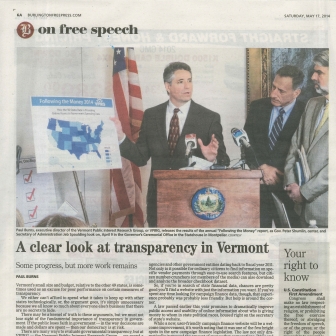Op-Ed by VPIRG Executive Director, Paul Burns
Published by the Burlington Free Press on Saturday, May 17, 2014
Vermont’s small size and budget, relative to the other 49 states, is sometimes used as an excuse for poor performance on certain measures of transparency.
We either can’t afford to spend what it takes to keep up with other states technologically, or, the argument goes, it’s simply unnecessary because we all know so much about everyone else’s business that there are no secrets to hide.
There may be a kernel of truth to these arguments, but we must not lose sight of the fundamental importance of transparency in government. If the public loses faith in government – in the way decisions are made and dollars are spent – then our democracy is at risk.
There are many ways to evaluate governmental transparency, but at VPIRG – the Vermont Public Interest Research Group – we spend a great deal of time following the money. That’s money spent to elect or defeat candidates, lobby our elected leaders, or run the government. Vermont turns out to be a leader in some areas and a laggard in others, but there’s always room to improve.
Let’s begin with an area where the state has been making great strides. Two years ago, when USPIRG released its national survey of online access to state government spending data, Vermont received a disappointing grade of D-. Since then, however, Governor Shumlin and his administration have made a real commitment to improving financial transparency, and that commitment was reflected in a much-improved grade of A- in this year’s report.
So, what does this new and improved grade mean? It means that Vermont is now one of the leading states in the nation when it comes to providing its citizens with easily accessible, web-based information concerning an array of state expenditures. This gives citizens the information they need to hold elected officials and recipients of public subsidies accountable.
Here’s one example of the kind of improved transparency we’re talking about. Vermont’s Department of Finance and Management has a website – SPOTLIGHT.vermont.gov – to provide the public with information on government contracts, economic development tax credits, and other state expenditures, all in a central location.
Vermonters also have access to a new tool that enables users to view the state’s checkbook-level payments to vendors from 66 departments, agencies and other government entities dating back to fiscal year 2011. Not only is it possible for ordinary citizens to find information on specific vendor payments through easy-to-use search features, but citizen number-crunchers (or members of the media) can also download and analyze the broader checkbook dataset.
So, if you’re in search of state financial data, chances are pretty good you’ll find a website with just the information you want. If you’ve spent any time looking for campaign finance data, though, that experience probably was probably less friendly. But help is around the corner.
A law passed earlier this year promises to dramatically improve public access and usability of online information about who is giving money to whom in state political races, housed right on the Secretary of State’s website.
While a new, user-friendly campaign finance website will be a welcome improvement, it’s worth noting that it was one of the few bright spots in the new campaign finance legislation. The law not only dramatically increased the amount of money that corporations, PACs and wealthy individuals can give to statewide candidates and political parties, it also failed to substantially improve disclosure requirements for candidates (increasing the number of possible financial reports from just seven to nine over a two-year period).
Lawmakers also considered, but ultimately rejected, the idea of having donors provide information about their occupation and employer. This data is now routinely collected in other states and at the federal level.
VPIRG urged legislators to demand more disclosure from Super PACs, too. For instance, we suggested that if a very wealthy person contributes more than 50 percent of a Super PAC’s revenue, then that person ought to be required to appear in any advertisements paid for by the PAC.
This “stand by your ad” provision would be similar to requirements now in place for candidates running for federal office. Our reason is simple: If someone is willing to spend hundreds of thousands of dollars to elect or defeat candidates in Vermont, that person should take some public responsibility for messages being sent out on his or her behalf.
Unfortunately, those election disclosure provisions never made it in the final bill signed by the governor. Clearly, we have more work to do.

